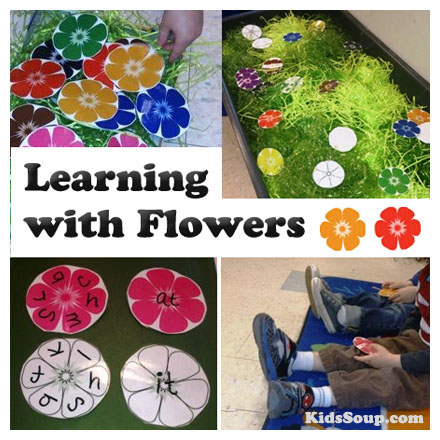The importance of instilling the concept of...

A preschool teacher shares four ways to incorporate flower cut-outs into the springtime classroom curriculum.
Grade, Age Range or Specialized Learner: Multi-age, Preschool/Pre-K, 3-5 year old
Target Learning Skills:
Learning with Flowers Four Ways
For each activity, print two copies of the Flower Cutting printable. Laminate each sheet and cut out each flower.
 Preschool Activities: |
 Preschool Activities: |

This activity works best with one large sensory table or tub where two to four children can play together. Fill the sensory table with green plastic or paper grass (the type typically used in Easter baskets). Lay the flowers on top and encourage children to find the matches based on color. To make the game more challenging, hide the flowers under the grass. Another option is for an adult to facilitate turn taking with the matching game to make the play more like a traditional memory game.
To adapt this activity for individual sensory tubs, use a color copier to shrink the flowers and make two sets of the smaller flowers per tub.

In addition to the flowers, you will need a marker to write on the flowers. A dry erase marker works best and will not damage the flowers. Pair the flowers by color, and write the endings of the word family in the center of one flower. Write the beginning letters for the family on the petals of the matching flower. Continue this process for as many sets as you need. Children can either read the words they create with the flowers or make a list on flower stationary.

For this activity you will need a dry erase marker, sunflower seeds (or a similar small seed), and flowers. This activity is versatile and is easily changed for your circumstances. If your children are working on counting with one-to-one-correspondence, write numbers on the flowers and have children count seeds, placing them one at a time on their second flower. If your class is working on simple math, write the problems on one flower and have them use the seeds on the second flower to find the answer. If you have children who are at varying levels, the dry erase marker makes it simple to customize and alter the lesson as you go along.

Give each child a flower to hold as they join circle time. It is okay to have duplicates. Once everyone is seated with their flower, explain that you are going to play a listening game and that they will need to listen closely to know where to put their flower.
Sing the following:
Put your flower on (your knee), on (your knee), on (your knee).
Put your flower on (your knee), and sing a happy song.
La, la, la, la, la, la, la!
The part in ( ) can be replaced with anything: the floor, your shoe, your head, your neighbor, etc. You can also give directions by removing “on” and replacing it with “to" (for example, to the left, the right, the front, the west, the north, etc.).
As children become familiar with the song, change it up a bit to keep them engaged. Try adding a specific color of flower: Put the (red) flowers on (the floor).

To transition child to the next activity, have them bring the flowers to you using the framework of the same song or similar songs which are listed below. You can use a box with some of the grass from the sensory activity or a piece of green construction paper to be a garden to place the flowers in.
This version works best if you are dismissing children to go to another activity:
Put the (purple) flowers in the garden, in the garden, in the garden.
Put the (purple) flowers in the garden. Then go (wash your hands).
(Repeat until all the children have returned their flowers.)
This version works best if you are transitioning to another activity in the same area. Children place their flowers in the garden and then, return to their spots.
Put the (purple) flowers in the garden, in the garden.
Put the (purple) flowers in the garden, in the garden.
All the (purple) flowers are in the garden. So….
(Repeat for each color)
Once the final color is called, finish the song with:
All the flowers are in the garden and now we’ll (do calendar).
Submitted by KidsSoup member Beth Steward.
KidsSoup Resource Library
